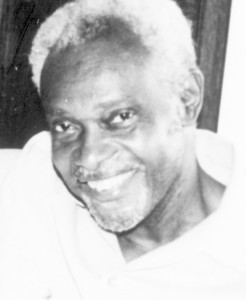By Nils Campbell
As the time counts down to Carifesta X next month, prize-winning Guyanese playwright Francis Quamina Farrier takes a stroll down memory lane to the year 1972 when Guyana launched the first Caribbean Festival of Creative Arts.

With his trademark gleefulness, he serenades with the words of “Welcome to Carifesta“ composed and sung by popular Guyanese calypsonian Lord Canary (Malcolm Corrica):
“Welcome to Carifesta ‘72,
Oh what a great cultural breakthrough…
Carifesta ‘72, Carifesta I’m inviting you
To 22 days of education, frolic and fun,
Carifesta ‘72, Carifesta it’s a big to-do,
We welcome you to CARIFESTA ‘72”
Farrier had been a leading light in bringing the festival to fruition. At age 70, he is still gifted with a nimbleness of wit to recall that it was conceived out of an appeal from a regional gathering of artists who were at the time participating in a Writers and Artists Convention in Georgetown, Guyana in 1970. The convention had coincided with Guyana’s move to Republican status.
Actually there were two successive conferences of outstanding Caribbean writers and artists — in 1966 and 1970 — and they recommended to then Prime Minister of Guyana, LFS Burnham that they would welcome the invitation to an annual festival of the arts. Guyana became politically independent in May 1966.
Farrier also recalled that the conference participants had decided that Guyana should establish a publishing house. Those dreams will one day be fulfilled, he said, brimming with optimism.
But it must have been a measure of satisfaction that in his time there was the launching of the film, Carifesta Girl. Farrier was then a young man and enjoyed the role of Assistant Director, serving under talented Guyanese Film Director Rudy David. By his side was Morris Bledman, another stalwart of the then highly productive and enterprising Film Centre, a unit of the Government Information Services.
He can never forget the role of Haitian-born dance choreographer Lavinia Williams in that film. She was the woman who was responsible for the establishment of Guyana’s Dance School which played a pivotal role in the success of Carifesta in 1972 and is set to soar to new heights in Carifesta X.
It must have been sorrowful for Farrier when he got word that the film Carifesta Girl had been conveyed to the incinerator on Princes Street and unceremoniously rendered to cinders by persons who didn’t have an appreciation of aspects of national heritage.
Still pleasant memories prevail of the artistes and writers who had been called to the “jam sessions” as they put their brains and their views together to make Guyana culturally free and progressive.
But a name that is outstanding along this Carifesta memory lane is Burnham. “Forbes Burnham played the role of facilitator or as you may call him, the person who ‘titillated’” us a little more about our work, our own lives, our experiences, our dreams and lots of other things. In addition to talking about the publishing house we talked about lots of other things…,” playwright and television personality Farrier declared, recalling the birth of dreams that will never die.
Burnham had related his vision of a cultural mecca for the region’s people – a vision of peoples with roots deep in Asia, Europe and Africa coming together to share, to perform their art forms. The dream embraced the literature inspired by the peculiar Caribbean temperament, paintings inspired by tropical jungles and art visualising the region’s forefathers.
In 1972 more than 1,000 creative artists from more than 30 Caribbean and Latin American countries displayed the creative activity of music, dance, drama, folk art, painting, sculpture, photography and literature.
The programmes included the folk chants and movements of the Conjunto Nacional of Cuba, the exotic Ibo dancers from Haiti and the sophisticated National Dance Company of Jamaica, masquerade bands and steel bands as well as the colourful Djuka and Javanese from Suriname, and the unique Rastafarian folk artists from Jamaica.
Guyana, the host country then as now, spared no resource and energy to achieve a festival of unprecedented standard.





